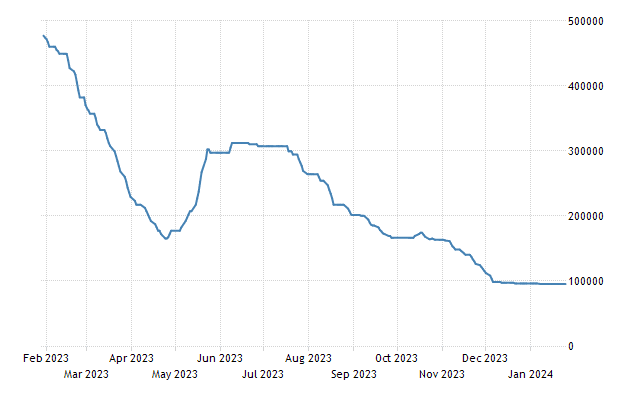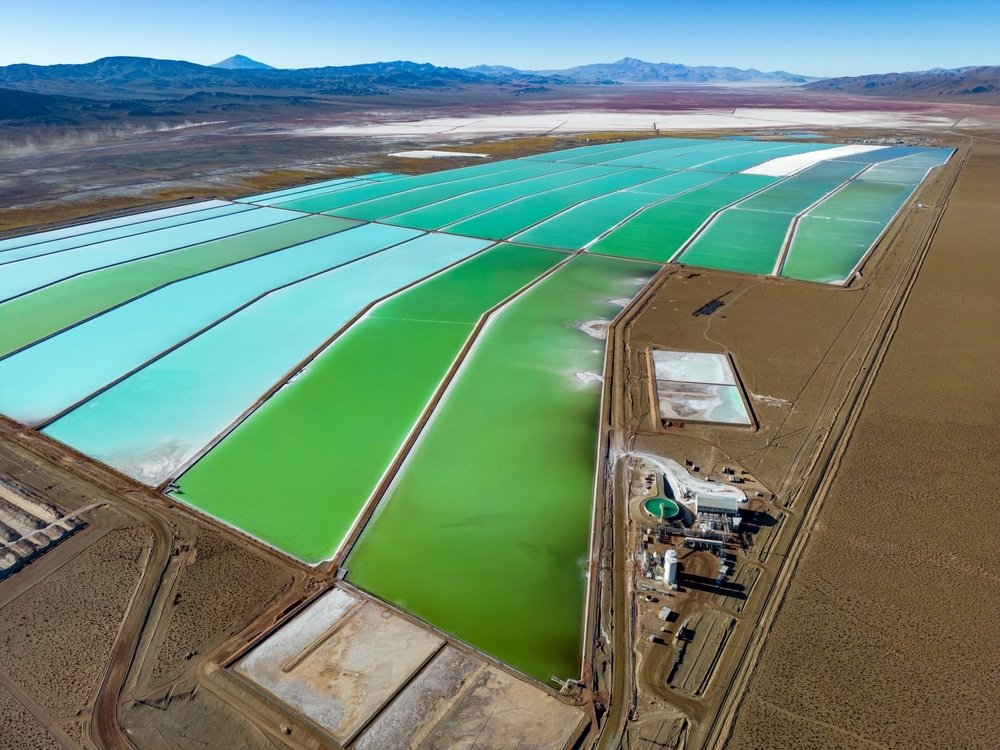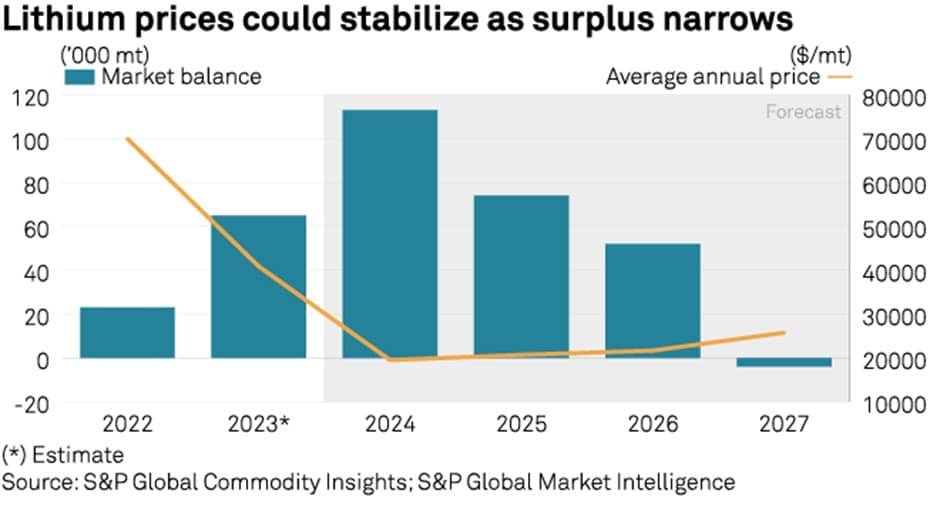Many investors are puzzled by the plunging lithium stock prices, especially considering the anticipated long-term demand. Let’s look into why this is the case and what is the market outlook for 2024/25.
The Steep Decline in Lithium Prices
The current decline in lithium prices can be primarily attributed to the slowing growth of electric vehicle sales in China. This is coupled with the broader slowdown in the Chinese economy.

As demand remains sluggish at previous pricing levels and supply surpasses demand, prices have inevitably fallen.
Lithium carbonate prices have experienced a significant decline in China. They dropped from a record high of $81,360 per tonne in November 2022 to $20,782 per tonne in the current month. This marks the lowest level in two years, reflecting a 67% decrease year-on-year.
In response to the plummeting prices, Chinese refining companies are taking measures such as cutting production or suspending operations.
The sharp decline in lithium carbonate prices represents a nearly 75% correction. Market analysts attributed this to a series of negative catalysts that have suppressed lithium prices.
What Makes Lithium Price Volatile?
It’s essential to recognize that lithium stock prices have historically been volatile in the short term due to various factors.
Lithium is a specialized commodity produced in limited quantities, making supply disruptions a significant factor in price fluctuations. Moreover, changes in consumer trends, particularly in consumer electronics and EVs, can swiftly impact demand and supply.
The lithium market is also influenced by geopolitical conditions and regulations, which can alter demand dynamics. Also, advancements in technology have introduced new extraction techniques, affecting total supply and prices.
There is also potential for increased involvement from major oil and gas companies. This is evidenced by recent statements from CEOs of Exxon and Chevron expressing interest in the lithium industry.
Additionally, a large private energy company Lowry is advising is exploring investments in lithium assets to support the global energy transition.
Although China has historically dominated lithium supply from Australia, the rise of Western converters is expected to redirect more Australian supply to Europe and North America. This shift may challenge China’s market dominance as the Western supply chain expands.
Point in case is Canada positioning itself to contribute to meeting the North American lithium requirements. This is where a junior Canadian lithium company, Li-FT Power (LIFT: LIFFF), comes into play.
The company focuses on consolidating and advancing hard rock lithium pegmatite projects in Canada, especially in known lithium districts. Li-FT Power is committed to advancing the exploration and development of high-quality lithium assets in the country.
Powered by Lithium: The Electrifying Role of EVs
Strategic investments to secure future lithium supply are on the rise. Major automakers and lithium producers are already committing over $1 billion in 2023 alone.
For instance, GM invested $650 million in Lithium Americas, while Albemarle allocated $110 million to lithium developer Patriot Battery Metals. This trend is expected to continue as companies seek to safeguard their access to raw materials for batteries.
The EV market is still in its early stages, with significant room for growth. As EV penetration increases globally, demand for lithium will outstrip supply, especially as EVs become mainstream.
Since batteries constitute a significant portion of EV expenses, this presents an opportunity for EV manufacturers to either increase profits per vehicle sold or, more likely, reduce prices to remain competitive as rivals do the same. Lower prices tend to attract more buyers, leading to increased demand for lithium.
Consequently, as the current oversupply diminishes, the price of lithium is likely to rebound. This cycle of falling prices leading to increased demand, followed by a reduction in supply, underscores the cyclical nature of the lithium market.
Short-Term Challenges and Long-Term Outlook
Despite short-term volatility, the long-term forecast for lithium remains positive. Lithium is crucial for decarbonization efforts, especially in the EV sector.
The global demand can surpass 2.4 million metric tons of lithium carbonate by 2030, doubling the 2025 forecast. BloombergNEF projects nearly a 5x increase in global lithium demand by the end of the decade, driven by rising battery demand for electric vehicles.
In the short-term, Goldman Sachs maintains a pessimistic outlook for lithium prices in 2024. The brokerage firm projects further declines compared to current levels.
The broker anticipates this downward pressure in lithium prices this year due to oversupply.
Initially predicting a return to market deficit in 2024, analysts now suggest a longer timeline, with the lithium market potentially bottoming out in 2025. Thus, Goldman Sachs maintains a bearish view on the market, adjusting their 12-month targets downward for China Lithium Carbonate and CME Asia CIF Lithium Hydroxide.
Known for its accurate forecasts, Goldman Sachs estimates the following prices for 2024:
- Lithium carbonate: $13,377 per tonne
- Lithium hydroxide: $14,263 per tonne
- Spodumene 6%: $1,250 per tonne
As per S&P Global estimation, lithium prices will start to stabilize beginning in 2025 as surplus narrows down. From there, prices would start to rise up again as seen below.
Amid current market challenges, the commitment to global net zero emissions by 2050 is expected to drive continued demand for lithium. More notably, long-term prospects remain strong fueled by growing EV adoption and global decarbonization efforts.
Disclosure: Owners, members, directors and employees of carboncredits.com have/may have stock or option position in any of the companies mentioned: LIFFF
Carboncredits.com receives compensation for this publication and has a business relationship with any company whose stock(s) is/are mentioned in this article
Additional disclosure: This communication serves the sole purpose of adding value to the research process and is for information only. Please do your own due diligence. Every investment in securities mentioned in publications of carboncredits.com involve risks which could lead to a total loss of the invested capital.



